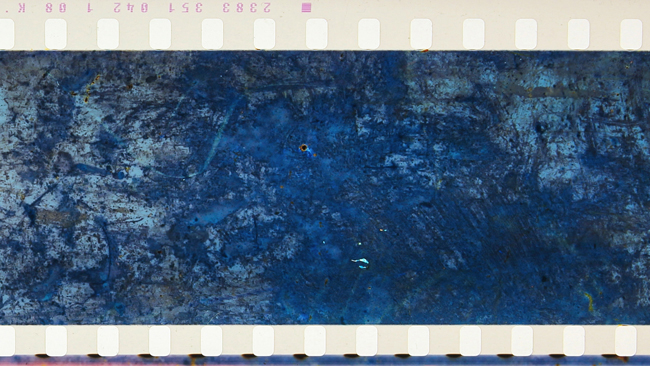
By Gregory Zinman
You don’t need a camera to make a moving image.
You can paint, scratch, and chemically alter celluloid, as Storm de Hirsch did to make portions of her psychoactive paean to female power in Peyote Queen (1965). You can bury your film in irradiated soil overnight outside the site of a horrific nuclear disaster, as Tomanari Nishikawa did to create sound of a million insects, light of a thousand stars (2014). You can affix Zip-a-Tone directly to the filmstrip to create the image and soundtrack, as Barry Spinello did for his Six Loop Paintings (1970). You can use saliva and fingernails to scrape calligraphic loops into emulsion, as Stan Brakhage used to create his final filmic utterance, Chinese Series (2003). Or you can develop your own replacement for celluloid altogether, as Donna Cameron did in films like World Trade Alphabet (2001) in order to draw out the relationships between literature, painting, and cinema.
Rather than represent the world by photographic means, these and other kindred moving-image artists seek to create new ways of seeing, staging a variety of interventions into the material makeup of celluloid. Seeking media not normally found in a filmmaker or artist’s studio, they mine their own bodies and their backyards for things to make into moving images. My forthcoming book, Making Images Move: Handmade Cinema and the Other Arts (University of California Press, 2019), provides a conceptual and historical framework for understanding these handmade moving-image works, as well as the technologies and tools used in their making. Making Images Move reveals how this seemingly anomalous subset of experimental films, devices, and practices in fact illuminates cinema’s close relation to the other arts, and reorients our understanding of the moving image.
While there are numerous cameraless works available from Canyon Cinema, including those mentioned above, they are rarely considered as a conceptual whole. A brief survey of these films indicates both the panoply of methods and the wide-ranging effects associated with this hands-on approach to cinema. That much of the resulting imagery is abstract in nature offers a welcome invitation to consider the role of abstraction in the moving image more generally. It also points to the ways in which moving image abstraction can escape formalism, offering visual and aural reassertions of documentary practice, the environment, and feminism, among other concerns.
Cameraless cinema challenges our ideas about how films are made and how they make meaning. Even with the collection plethora of indexical indicators afforded by digital photography, such as geo-tracking and time stamping, a significant appeal of the cameraless film lies in its ability to provide a more immediately recognizable link between artist and world. The embedded materiality associated with this kind of handmade cinema—its ability to capture flecks of paint, seawater, acid, or sand—hews closely to the original conception of the index, as formulated by semiotician Charles Sanders Peirce. According to Peirce, a sign’s relationship to its referent is characterized as “being really and in its individual existence connected with the individual object.” Cameraless film contests the binary between abstraction and representation, arguably usurping traditional photography’s capacity to render the world. In this way, cameraless film can be understood as an indexical carrier par excellence—a form of documentary practice wherein the traces of an artist’s physicality are imprinted on the celluloid, thereby providing a guarantee of bodily presence in both space and time: someone has laid their hands on this material.1 For example, the hand-painted words, circles, lines, and grids populating Spinello’s ebullient Sonata for Pen, Brush & Ruler (1968) aren’t just geometric forms or linguistic signifiers, but rather, according to the artist, a form of self-portraiture: “It is my brain; for ten minutes I expect that the viewer’s brain functions as my brain.”2
Cameraless films can also harken back to earlier strategies for making images. Anna Geyer’s ARAPADAPTOR (I Feel So) (2003) brings together found footage and the artist’s photograms of “the caterpillars, cicadas and seeds of the herbal packages,” which she then painted over, tinted, and bleached. Her reworked images of the natural world result in apparitions whose hues evoke those found in botanist Anna Atkins’ British Algae: Cyanotype Impressions, cameraless works which comprised the first published collection of photographic images in 1843.
The cameraless films at Canyon can help start conversations between generations of the avant-garde, as well as about how we imagine the place of humanity in the present world. The gathering hailstorm of monochromatic stipples in Ben Russell’s Black and White Trypps Number One (2005) sends viewers hurtling through an imaginary cosmos, recalling Brakhage’s similarly themed—and similarly hallucinatory—Stellar (1993). That film, which the artist dubbed a “visual envisioning of outer space,” makes extensive use of black leader to create striking contrasts in figure-ground relations, punctuating prolonged passages of darkness with flaming thickets of color.
Other cameraless films engage the elements even more directly. Take David Gatten’s six-film series What the Water Said (nos. 1–3, 1997–98; nos. 4–6, 2006), in which he placed unexposed film into a crab trap in the Atlantic Ocean off the South Carolina coast, letting the film rest in the murky depths as saltwater, sand, rocks, crabs, and fish had at the celluloid. Such methods suggest a Cageian relationship between enunciator and artist, one that promises an unfamiliar accounting. Gatten’s labile films burst with color and static. The stuff of the sea appears within the optical sound area as well as the image track, and so can be said to generate the music that is heard when performed by the projector. These are works that understand themselves as having entered into a series of relations, and, in turn, can be understood as a record of communication between the ocean, its organic and inorganic components, and humanity. When Gatten retrieved the unspooled films from their traps, he rinsed but did not develop the filmstrips. He let the work of the sea and its creatures on the film’s emulsion stand on its own—a series of reticulations like the veins of a leaf, entire pieces of celluloid torn from the filmstrip, and altered passages in tan, rose, and violet. When projected, the short films (the longest has a runtime of just over three minutes) are dizzying in their speed, and their throbbing displays of color and light seem simultaneously playful and mysterious.
Gatten’s films were made in a spot he has returned to many times throughout his life. Louise Bourque similarly imbues her 35mm Jours en fleurs (2003) with both biographical and biological meanings. Here, Bourque offers an example of the relationship between human reproduction and the reproduction (and destruction) of cinema. Bourque’s film takes its title from a French-Canadian expression for menstruation that she recalled from her youth. Bourque subjected images of sprouting trees to “incubation” in her own menses, darkening the image, and allowing the bloody agent to encroach upon and transform the photochemical emulsion, abstracting the original representation of flowering nature through an encounter with the real substance of the human reproductive cycle. Bourque’s film describes a media ecology in which her chosen materials create a play between the natural processes of fertilization, birth, waste, efflorescence and deterioration. Jours en fleurs, like Spinello’s Sonata for Pen, Brush & Ruler, stands as a kind of self-portrait. But its dual subject of trees and menstruation also, like Gatten’s films, opens its purview to consider humanity’s place in the larger natural world. In addition, by applying a distinctly female element of the human body to the film’s emulsion, Bourque offers a feminist counterexample—a true “woman’s film”—to the all-too familiar sexual objectification of the female anatomy found in commercial cinema.
A critique of that very objectification anchors Removed (1999), for which Naomi Uman took a dubbed European 1970s porn film and proceeded to erase the figure of the woman, frame by frame, using nail-polish remover and bleach. The writhing white figure that results from this erasure interacts, abstractly, with a series of leering men, providing a satirical take on the trope of the male gaze and the suppression of the female voice. Here, abstraction is put into service of an ironic feminist critique—a disfigurement to the point of erasure that denies heteronormative masculine visual pleasure in order to rethink the representation of women in film.
If Uman demonstrates a frustration with the male gaze, Jennifer Reeves’s The Girl’s Nervy (1995) invites a darker consideration of the gendered mind and body under duress. Reeves counts both Brakhage, who hand-painted dozens of films from the 1990s up until his death, and Carolee Schneemann, whose re-photographed and hand-painted Fuses (1964-1967) posits feminist erotics as personal documentary and as tacit anti-war protest, as critical influences, and their respective interests in probing mind, body, and identity through abstraction course through Reeves’s work. Reeves was institutionalized during her junior year of high school, and her explorations of mental interiority and medical imagery consequently carry a strong autobiographical current. The title of The Girl’s Nervy sounds like a glib diagnosis, while simultaneously playing upon historical and literary conventions regarding the ways in which women were thought to be prone to nervous illnesses. Visually, the film represents a case study in horror vacui. Reeves suffuses frames of densely painted clear leader and photographed images over a warped big-band soundtrack of Glenn Miller and Tommy Dorsey, which runs backwards at the film’s outset. As suggested by the work’s title, the color splatters appear like the synapses or nerve endings of a sensory skeleton. The music from a bygone age speaks to nostalgia and invites us to dance, while its reversal tells about the passage of time and the way memories can be warped. This theme is also apparent in the film’s images, which resemble brain dendrites rushing by like traces of memory that continuously slip away, a condition shared by the viewer who experiences Reeves’s film as a series of impressions, rather than precisely rendered moments. The resulting effect is a depiction of a troubled mind in motion.
Cameraless abstraction can also be understood as a reaction to and protest against the kind of photographic films that reach the broadest audiences. Jon Behrens, who has made a number of hand-painted films, takes up media preservation and re-presentation in his Recycled Realizations (2017), which repurposes 35mm trailers from Hollywood productions of the 1990s into an assemblage upon which the filmmaker could paint, scratch, and optically print layers of coruscating color, reversing the flow of the cultural industry from exploitation of the avant-garde to a reclamation that asserts its own hypnotic spectacle. Seen on a big screen, it’s both more mysterious and more awe-inspiring than any CGI explosion. (CGI being a rather more expensive form of cameraless imagery.)
Differently made, works like those described above not only confirm the horizon of aesthetic possibility offered by cameraless films; they also indicate how the techniques used in their construction, which run counter to conventional photographic filmmaking methods, can be vehicles for expressing counter ideologies.
Gregory Zinman is an Assistant Professor of film and media in the School of Literature, Media, and Communication at the Georgia Institute of Technology. He is the author of Making Images Move: Handmade Cinema and the Other Arts (2020, University of California Press), and a co-editor, with John Hanhardt and Edith Decker-Phillips, of We Are In Open Circuits: Writings by Nam June Paik (2019, the MIT Press).
General & Title Inquiries
Canyon Cinema Foundation
1777 Yosemite Ave Suite #210
San Francisco, CA 94124


